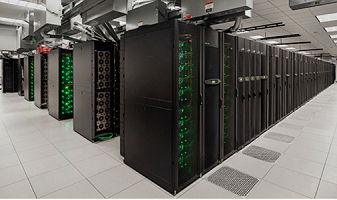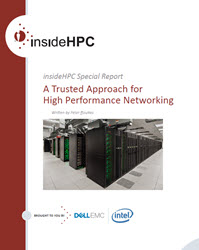This is the fourth entry in our series of features covering high performance system interconnect technology, HPC networking and computing. This series, compiled in a complete Guide, is focused on HPC networking trends. This entry is focused on how to select HPC network technology and solution partners.
Selecting a High Performance Network Technology and Solution Partner
Although the available HPI technologies are split between standard and non-standard approaches, they can be treated as equivalent for most intents and purposes. The ubiquitous market presence of Intel’s processor architecture and its partner ecosystem places Omni-Path on an equivalent trajectory to InfiniBand or Ethernet from a commercial perspective, despite its relatively recent introduction to the HPI market. The selection of the primary solution vendor then becomes a much more important choice.
The server market is experiencing some significant transitions. Over 80% of enterprise servers are now based upon Intel IA technology according to IDC, and in the TOP500 over 90% of systems are IA-based. In such a standardized technology market few vendors beyond the top two or three vendors can afford to invest in added value capabilities.
With three primary network technology options widely available, each with advantages and disadvantages in specific workload scenarios, the choice of solution partner that can deliver the full range of choices together with the expertise and support to match technology solution to business requirement becomes paramount. Three important criteria are:
- Ability to place, support and maintain a system in the TOP20 HPC systems in the world
- Proven support for all high performance network technologies and standards without bias
- Understanding of workload performance criteria and ability to propose optimized systems
Beyond support for core technologies or custom approaches, each vertical industry has a set of standard workloads and requirements that need to be supported and tuned. Individual market ecosystem initiatives to support major market segments such as life sciences, manufacturing, general research or other areas provide a solid basis for business specific solutions, but individual system and software configurations still need to be tuned for optimum efficiency.
With the industry in transition, and established technologies available from most system vendors, it is interesting to consider which of the leading vendors are also on the cusp with TOP500 systems using Intel Omni-Path alongside InfiniBand and Ethernet, and carving a presence amongst the world’s leading systems providers.
Dell EMC has a lighthouse system in the TOP20, Stampede – an InfiniBand-based system that is currently number 17 on the TOP500. Stampede is in the process of being upgraded to a second generation Dell EMC / Intel Omni-Path system which is likely to put the Texas Advanced Computing Center (TACC) back in the TOP10.
Together with Dell EMC’s position as an enterprise server provider, Dell EMC’s customer base spans each of the three dominant high performance interconnect categories.

The Dell EMC / Intel Stampede Supercomputer at the Texas Advanced Computing Center
Dell EMC HPC Systems Portfolio
Beyond the core technology components, different vertical industry workloads have specific configuration requirements and tuning characteristics. Dell EMC is leveraging its expertise which includes advanced Intel-powered HPC systems to ease and accelerate customer adoption of industry focused systems. In June 2016, Dell EMC announced the global availability of the Dell EMC HPC Systems portfolio, a family of HPC and data analytics solutions that combine the flexibility of customized HPC systems with the speed, simplicity and reliability of pre-configured systems. Dell EMC engineers and domain experts designed and tuned the new systems for specific science, manufacturing and analytics workloads with fully tested and validated building block systems, backed by a single point of hardware support and additional service options across the solution lifecycle.
With simplified configuration and ordering, The Dell EMC / Intel Scalable System Framework®-based systems include the latest Intel Xeon® processor families, support for Intel Omni-Path Architecture (Intel OPA) fabric, and software in the Dell EMC HPC Lustre Storage and Dell EMC HPC NFS Storage solutions. Three new offerings include:
- Dell EMC HPC System for Life Sciences – Designed to meet the needs of life sciences organizations, this enables bioinformatics and genomics centers to deliver results and identify treatments in clinically relevant timeframes while maintaining compliance and protecting confidential data.
- Dell EMC HPC System for Manufacturing – Enables manufacturing and engineering customers to run complex design simulations, including structural analysis and computational fluid dynamics.
- Dell EMC HPC System for Research – Enables research centers to quickly develop HPC systems that match the unique needs of a wide variety of workloads, involving complex scientific analysis.
Dell EMC has adapted its traditional customer focused strategy to focus on business specific, workload and service focused solutions.
Beyond standard products and industry focused offerings, Dell EMC recognizes that HPC users have specific individual needs, frequently requiring access to the very latest technology advancements and systems configured and tuned to optimize performance on specific workloads. Additionally as part of the company’s transition to address the current technology market realignment, Dell EMC has adapted its traditional customer focused strategy to focus on business specific, workload and service focused solutions. These address the future requirements of Internet of Things (IoT), big data, real time analysis, high performance computing and deep learning.
Network Technology
Dell EMC products cover the full range of network technology and now includes the latest Intel Omni-Path technologies in the Dell EMC H-Series switches based on first generation Intel Omni-Path Architecture (OPA):
- Dell EMC H-Series Edge Switch is purpose-built 48-port ASIC design that provides for improved fabric scalability and reduced latency, increased density and reduced cost and power, while enabling 2-tier configurations for up to 27,648 nodes.
- Dell EMC H-Series Director-Class Switches offer a maximum of 768 ports, in 32-port increments, each providing 100Gbps performance, scaling up to 19.2 terabits per second (Tb/s) of aggregate bandwidth.
Although first generation OPA products are expected to conform to the initial Intel specification, subsequent generations from companies like Dell EMC will gain a significant advantage from the experience of delivering TOP20 systems such as the TACC Stampede 2 system based on Intel OPA technology.
Over the next few weeks we will dive into the following additional topics on HPC Networking:
- Special Report on top Trends in HPC Networking
- High Performance System Interconnect Technology
- HPC Networking Trends in the TOP500
- The Dell EMC HPC Innovation Lab
If you prefer you can download the complete report, A Trusted Approach for High Performance Networking, courtesy of Dell EMC and Intel.





